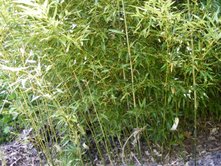Bamboo: Difference between revisions
No edit summary |
(+ category) |
||
| Line 54: | Line 54: | ||
[[Category:Food and Agriculture]] | [[Category:Food and Agriculture]] | ||
[[Category:Materials]] | [[Category:Materials]] | ||
[[Category:Construction]] | |||
Revision as of 14:28, 28 August 2016
Introduction
What is the largest bamboo for growing in the Kansas City area ? Phyllostachys nuda is up to 34 feet high and 2 inches in diameter, but the website: http://www.lewisbamboo.com/nuda.html says it will grow only 10 feet in zone 5.
Columbia, Missouri Example
Location: Columbia, Missouri
Source: Yuyi Lin
Attached are the bamboo photos taken early this year. The bush is large enough for us to harvest a few pounds of fresh bamboo shoots this year. It tasted really good. In my home town (Fujian Province, China), the soil is red colored, a little on acidic side, and mostly clay type, bamboo grows very well and become very large. I put oak leaves in Fall on the bush to help the root from cold winter. For last a few years, the leaves did not turn yellow but remain green all year round, which is helpful. I will look into using large bamboo stem as bow material, but cannot do it quickly.
Uses
(this section needs to be expanded)
Construction material, scaffolding, furniture, panels (e.g. flooring), in agriculture (e.g. trellises), decoration, fabrics and clothing, rugs, food (e.g. bamboo shoots), biocomposites, durable utensils, etc.
Treatments for Preservations
Chemical Treatment For Stuctural Use
"Here's a mild chemical treatment recipe: Mix 10kg boric+15kg borax for 200lts water (warm enough to dissolve the borax in it). Puncture the bamboo nodes and fill it up with this solution. Let it stand saturated for a week. Let it dry and ta-daa, it's ready to be used!" [1]
Heat Treatment (insert details here)
compare to: Wood Preservation by Carbonization + bamboo composite



